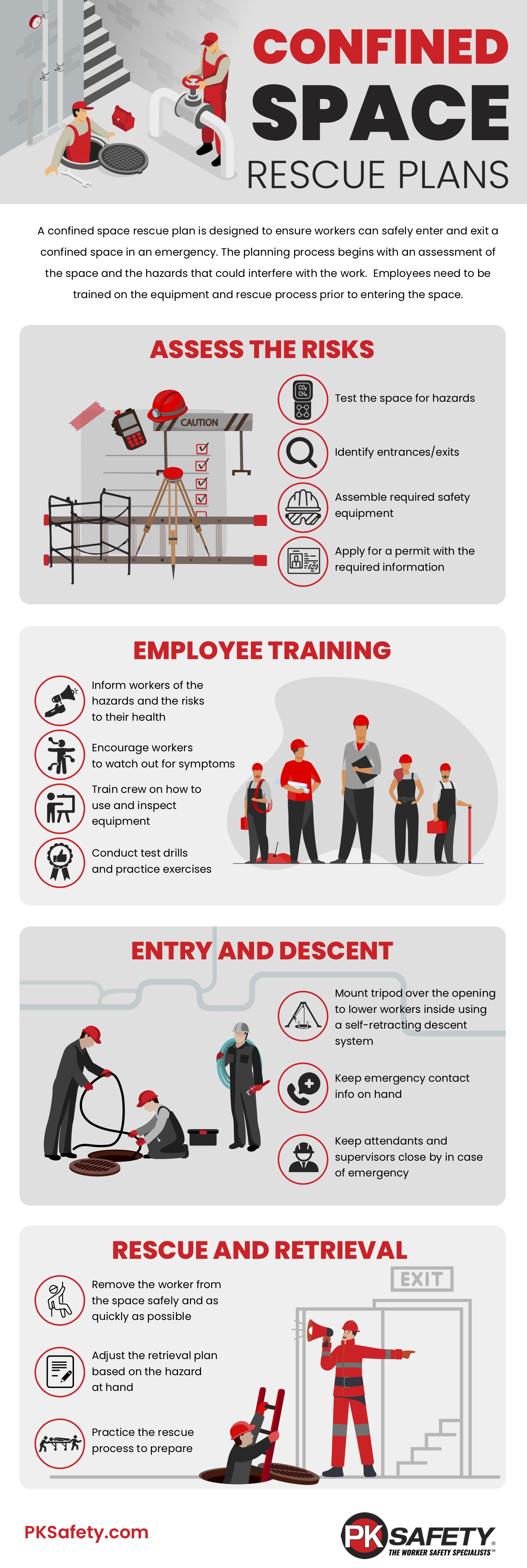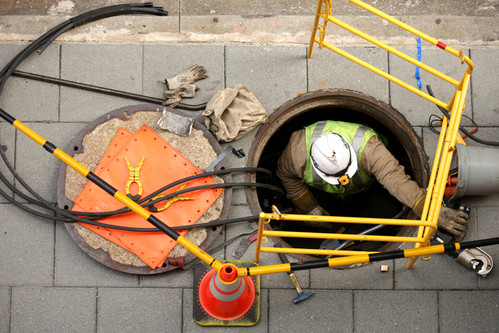Confined Space Rescue Plan

Every workplace needs a confined space entry and rescue plan to ensure workers know how to stay safe when in spaces unfit for continuous human occupation. Workers may need to go into all types of confined spaces, including storage tanks, utility tunnels, basements, crawl spaces, and manholes. These areas usually have a limited number of entrances/exits, which can make it difficult for workers to escape in an emergency. Water can fill the space, trapping workers inside. The walls or ceiling in the space may be structurally unsound, causing debris to fall overhead.
Confined spaces can also contain hazardous gases that can ignite under certain conditions. The space usually has poor ventilation, which can make it hard for workers to breathe. Exposure to toxic gases can lead to a range of permanent health issues. Individuals occupying the space may need to wear Personal Protective Equipment (PPE), including respirators with access to oxygen. These spaces can easily trap excess heat that can interfere with the job at hand. If these hazards are present in the space, workers must be able to escape quickly.
Each space presents unique challenges that must be dealt with prior to entry. Companies and construction crews can use this guide to create an effective rescue plan for confined spaces.
How to Create a Confined Space Rescue Plan
The Occupational Safety and Health Administration requires workers and teams to develop a confined space emergency rescue plan when entering or occupying those areas that require a permit.
Assess the Hazards
Before entering a confined space, properly assess the space in question. A workspace qualifies as a confined space if it is large enough for human occupation with limited entrances/exits and poor ventilation. These areas aren’t meant for continuous human occupation. The space may qualify as confined regardless of the hazards in place.
The confined space rescue plan must be designed specifically for the hazards present in the space. Workers will need to conduct a variety of tests and inspections to better understand the risks involved. This can include researching the work environment, testing the air quality, and learning about the conditions inside the space.
The workers will need to identify the equipment they will need to use to get in and out of the space safely should any of these incidents occur. Conditions inside the space may change, and managers should identify possible situations that could increase the risk of injury.
The team will need a Confined Space Entry Permit to perform work in the space, which includes information about the confined space emergency rescue plan. The application should include:
- The location and name of the confined space.
- The nature of the work involved
- Time and date of occupation
- The names of authorized employees and supervisor
- Potential hazards in the space
- Air quality data and other testing information
The permit application allows the crew to put their rescue plan on paper. Every possible risk and hazard should be included with clear instructions regarding how the rescue should be performed.
Employee Training
After accounting for the hazards, the team can begin implementing their plan by training employees on what to do in an emergency. The workers should be aware of the hazards in the space and how they can affect their health. It’s up to each person to monitor themselves and each other for possible symptoms of hypoxia and narcosis if hazardous gases leak into the space or someone’s respirator malfunctions.
The crew may find it necessary to conduct test drills inside the space at the beginning of the shift to ensure the crew can execute the plan in a timely manner. Individuals should also be fully trained on how to use the PPE, including respirators, harnesses, rescue equipment and descent systems, and gas monitors. The equipment must be inspected and tested at the start of every shift.
Entry and Descent
Those designated to occupy the confined space will then enter into the space. In some instances where a worker may need to descend into a confined space, they may require the use of a tripod and self-retracting rescue system to be safely lowered into the space. A supervisor and at least one attendant must be present near the entrance/exit in case the worker needs to be rescued. Keep emergency contact info on hand in case of emergency. The worker should be able to enter the space without injuring themselves. The line should be slowly extended to ensure the worker doesn’t fall too fast.
Rescue and Retrieval
The worker should then be rescued from the space in the event of an emergency. Again, it’s important to run test drills before a real emergency occurs. The rescue and retrieval may need to be adjusted based on the type of hazard in place. Some teams designate between rescue and retrieval plans. The former is for bringing workers out of a space, while the latter is used to search for and retrieve workers who may no longer be alive.
Recent Posts
-
Customizing Gas Detectors: Tailoring Solutions to Fit Your Unique Requirements
In today’s diverse industrial landscape, a one-size-fits-all approach to safety simply doesn’t cu …Jul 3rd 2024 -
10 Ways to Prevent Wildfires
You can prevent wildfires by extinguishing flames before you leave the worksite. Avoid practicing …Jul 1st 2024 -
ANSI/ISEA 138 Safety Gloves: Ensuring Hand Protection
The human hand is an anatomical masterpiece and arguably the greatest tool attached to our bodies …Jun 25th 2024





